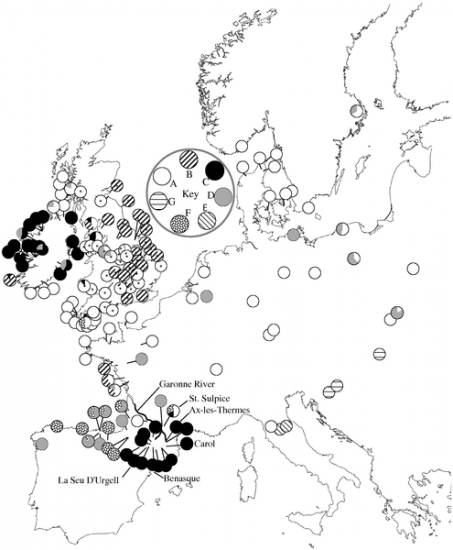Mesolithic humans may have carried snail species from France to Ireland
Public Library of Science
Source - http://www.eurekalert.org/pub_releases/2013-06/plos-sgt061313.php

Distribution of main C. nemoralis mitochondrial lineages across Europe. Some samples that have been used previously [10], all British, are indicated by an * in the pie chart. Pyrenean locations that share identical haplotypes with Ireland are shown doi:10.1371/journal.pone.0065792.g002
Some snails in Ireland and the Pyrenees are genetically almost identical, perhaps because they were carried across the Atlantic during an 8000-year-old human migration. The snail genetics tie in with studies of human genetics and the colonization of Ireland, according to the research published June 19 in the open access journal PLOS ONE by Angus Davison and colleagues from the University of Nottingham, UK.
Despite being thousands of miles apart, one variety of banded wood snails from Ireland and southern France share similar shell patterns and mitochondrial genes that are rarely seen in other areas of Europe. Davison explains, "There is a very clear pattern, which is difficult to explain except by involving humans. If the snails naturally colonized Ireland, you would expect to find some of the same genetic type in other areas of Europe, especially Britain. We just don't find them."
He adds, "There are records of Mesolithic or Stone Age humans eating snails in the Pyrenees, and perhaps even farming them. The highways of the past were rivers and the ocean – as the river that flanks the Pyrenees was an ancient trade route to the Atlantic, what we're actually seeing might be the long lasting legacy of snails that hitched a ride, accidentally or perhaps as food, as humans travelled from the South of France to Ireland 8,000 years ago."
###
Citation: Grindon AJ, Davison A (2013) Irish Cepaea nemoralis Land Snails Have a Cryptic Franco-Iberian Origin That Is Most Easily Explained by the Movements of Mesolithic Humans. PLoS ONE 8(6): e65792. doi:10.1371/journal.pone.0065792